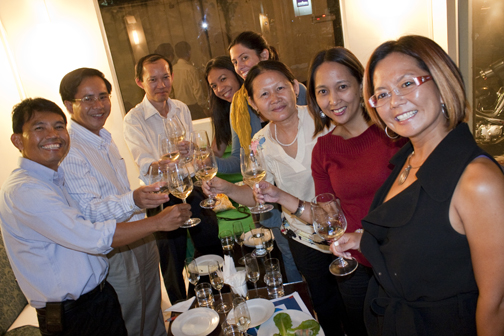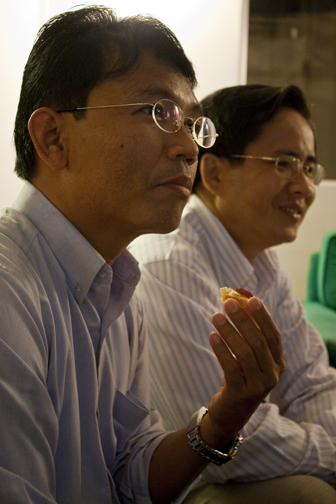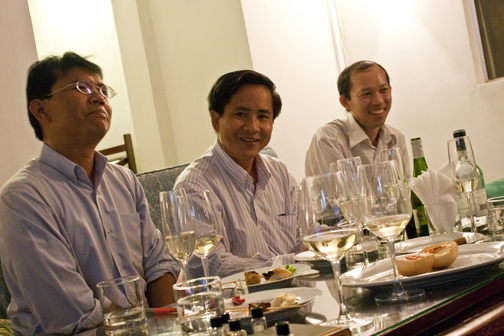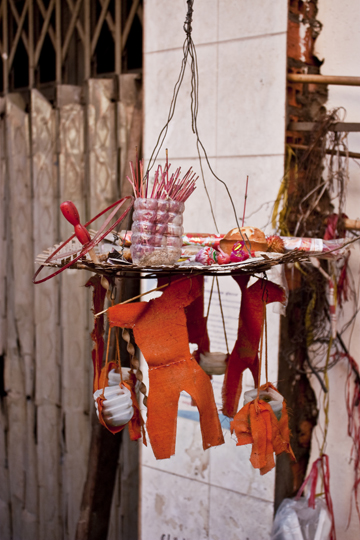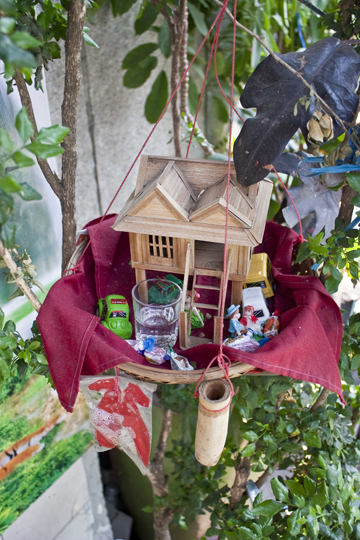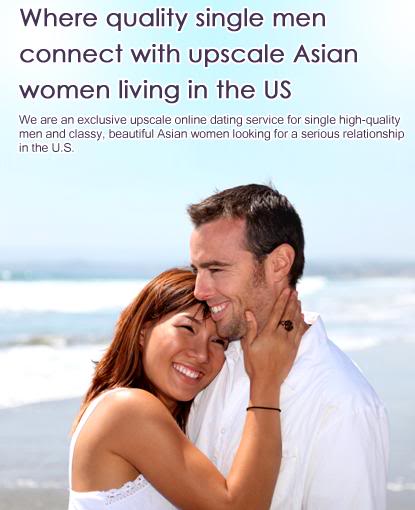On my final day with the team at the GTZ Health Programme, my fellow technical staff and I were treated to a wine tasting event with Remie (@Vinotage). Got to support a budding entrepreneur and also Java Arts Cafe, which is a great advocate for and supporter of the budding artistic community in Phnom Penh. This group fostered a great environment for success, both on personal professional level and in reaching project goals. I’ll miss them.
offerings to the small lost souls..
This post is about Merenang Kang Veal, the memorials and offerings to those who’ve passed into the next life while still very young (from the aborted to the stillborn to those who died at a very young age). The relationship with nature and all living things whether still on earth or physically gone is still very tangible and real in Asia and the Khmer’s Buddhist tradition. These shrines and offerings are an effort by those still alive to pay respects and appease the wandering and lost spirits. Notice the toys and miniature clothes, food and water given as offerings. We’re doing some research into these to find out more about them. Stay tuned!
FTAs and Big Ag’s equivalent of the “financial innovations”
..there is strong pressure on India to join the International Union for the Protection of New Varieties of Plants (UPOV) -1991, which would make Indian farmers pawns of multinational companies engaged in crop research. Joining UPOV-1991 would crush farmers’ privileges to share, exchange, and sell plant variety protection (PVP) seeds to other farmersPVP guarantees IP protection to plant varieties developed by agricultural multinationals. The objective of UPOV is to protect new varieties of plants by IP. Harmonisation of PVP across the Asia Pacific region is the aim of developed economies through FTAs, say experts.
Why do we always aim for the high tech solutions? There is certainly value in drought-resistant and salt-tolerant varieties, but many local /native varieties can provide significant increases in yields with improved low-tech techniques. Preserving native varieties and not eradicating them in favor of frankenplants emerging from Big Ag’s R&D pipeline is just plain smart.
Now consider patenting seed varieties in this angle presented in the webzine Grist.com, Are GMOs the ‘financial innovations’ of agriculture?
In a sense, Big Ag — along with the Obama administration — is doubling down on the industrial system we have now: one that is already starting to show signs of stress, from the rise of superweeds along with the price of oil. Monsanto and Syngenta are claiming the ability to genetically engineer all the risk out of agriculture. But in narrowing farmers’ choices to a small set of patented seeds, seeds that must be bought by and distributed to every far-flung farm in the world every year (most of which lack basic infrastructure like, say, roads, and which must grow them according to strict protocols), these companies presume to have managed all the risks, just like the banks did a few years back. They are also presuming that the “Business as Usual” scenario, the world as it exists today, will continue indefinitely; that, in other words, there are no Black Swans hiding in the reeds.
As Salmon describes it for us so clearly, it’s a huge gamble. Only this time we’re not gambling with money — we’re being asked to gamble with our breakfast, lunch, and dinner, and farmers with their livelihoods. That is a bet that none of us should have to take.
The new new imperialisms, one after another, developing as fast as the speed of technology. Governments are now the instruments of protection for corporations rather than the population. That’s certainly the reality in the US given its recent Supreme Court decision giving corporations the same status as people. ASEAN has problems of its own and it won’t even know what hit it.
People really must find ways to organise outside of government solutions. But are citizen organisations fast enough? Time for the Do’s and Don’ts of 21st Century Strategy.
crisis innovations
One of the frustrations of working on a development project with a focus on policy work is that the impact on very urgent needs is years away. There is certainly value to shaping the legal environment to pave the way for changes to set roots. But as I mentioned in an earlier post about why I use twitter, I’m interested in how social issues are tackled now, across different continents.
So check out the practical ideas borne out of crises around the world. One of them hit the NY Times lately, Africa’s Gift to Silicon Valley: How to Track a Crisis.
@Ushahidi suggests a new paradigm in humanitarian work. The old paradigm was one-to-many: foreign journalists and aid workers jet in, report on a calamity and dispense aid with whatever data they have. The new paradigm is many-to-many-to-many: victims supply on-the-ground data; a self-organizing mob of global volunteers translates text messages and helps to orchestrate relief; journalists and aid workers use the data to target the response.
Ushahidi also represents a new frontier of innovation. Silicon Valley has been the reigning paradigm of innovation, with its universities, financiers, mentors, immigrants and robust patents. Ushahidi comes from another world, in which entrepreneurship is born of hardship and innovators focus on doing more with less, rather than on selling you new and improved stuff.
Because Ushahidi originated in crisis, no one tried to patent and monopolize it. Because Kenya is poor, with computers out of reach for many, Ushahidi made its system work on cellphones. Because Ushahidi had no venture-capital backing, it used open-source software and was thus free to let others remix its tool for new projects.
This and other platforms eg @frontlinesms are available to help villagers self-organise so that resources can be targeted to meet their needs. It has great potential for maternal and child health problems, and for access to health care issues.
It’s time to bounce ideas around..
new dating site for finding submissive Asian ladies
So there’s this new website pandering to all the stereotypes about Asian women. Ah, progress the modern way: to get dumb and dumber. No need to have any sense whatsoever or plain smarts anymore. Thinking is taboo; we will fight for the freedom to be ignorant as long as Wall Street, Big Ag, Big Pharma or any other alchemist with magic to peddle will simply spoon feed us our most basest desires. Heck, let ’em roll our economic reality into a black hole while our government deficit spends and bails these buffoons out for nonsensical wars so we can set the next one up and rule the world. No, really rule the world.
But I digress. Here’s a less grandiosely oversimplified commentary from Sociological Images:
[These Asian women] aren’t trying to use you to get to the U.S. (though, after stating these are women living in the U.S., they are always described as Asian, not Asian American). And the men who want to date them just love and respect “the Asian culture” (and, you know, there’s just one culture in all of Asia). And how do you show your appreciation for a culture? By marrying someone who personifies the elements of that culture you have romanticized.
Unlike “the average woman” (which presumably means White women in the U.S., since we’re the majority of women and all), Asian women haven’t become too competitive (just intelligent and independent! But that’s different!) and certainly aren’t “masculine.” Again we see the romanticizing of a certain stereotype of “Asian culture,” with Asian women having a “well-known cultural attitude of gentle and caring support” and “Eastern values,” which apparently involves being sweet and supportive. Though they’ve also “learned Western values,” which here is associated with being “outgoing…independent and fun…”. Thus, the West = independent, fun women, while the East = supportive, submissive ones.
Sigh.
thanks to MacMall’s incompetence i found a better Apple retailer
An excellent piece by Tony Greenberg, Why Good Service is About Trust, made me recall why we won’t be purchasing from MacMall.com again. This summer on a trip back to the US, my husband and I placed quite a large order with them for equipment to take back abroad. Being a graphic designer, Keith wanted a quad core mac tower (the best specs at the time of the order) and an equally able MacBook Pro for mobility. And a few programmes including the shockingly expensive Adobe Professional Suite upgrade.
With a four-week window in NYC we needed assurance about delivery– not a problem for most companies and certainly assured us by MacMall’s rep before we placed our order. First it took them a week and a half to authorise such a large order (really MacMall? that long to process a credit card authorisation for a measly ~$10,000?). Then two days before our flight there was no sign of delivery, no call or email notification about a delay. Had we been advised that the entire order was delayed by one spec, we actually would have gladly settled for a less than ideal workstation. We just didn’t want to waste our holiday doing any shopping, which is why we went online for this order.
But there was absolutely no communication. Numerous calls and emails from us over the last week prior to our flight were handled with lukewarm assistance by MacMall reps. Finally after one last wasted day on many frustrating calls and getting put on hold all the way up the management chain we canceled the order and hopped a cab to B&H, a photo/video/electronics megastore for professionals (not far from my Manhattan apartment). MacMall realised they were losing us and actually had the audacity to FedEx the order–with the delayed spec and all!– but it went Back to Sender.
Considering the circle of friends, family and clients that my husband and I regularly interact with, that’s a heck of a lot of bad PR for MacMall. Through MacMall’s staggering incompetence, we found that B&H is actually a MUCH better retailer with a stellar reputation and impeccable customer service. The (literally just-released!) 2.93Ghz Quad-Core Intel Xeon “Nehalem” processor we ended up with under advisement from the B&H rep is actually a much better machine than the 3.2Ghz Quad-Core we were struggling to get delivered from MacMall. Plus, due to its architecture, it cost us $2000+ less! I have to remember it pays to go to a physical store and talk to knowledgeable reps!
Here’s what Mr Greenberg had to say about MacMall:
..MacMall, a Torrance, CA. based distributor of Apple computers and related gear. It’s the same firm as PC Mall… I guess poor customer service is a core MacMall positioning element that I could have known about ahead of time. Note MacMall’s low consumer rating on ResellerRatings.com. If you were ever to consider returning or replacing a product, it would be one of the worst places you could choose. Out of thousands of online resellers, to me it seems like it’s just one step above a phishing site. MacMall execs, I suggest you look at the Apple stores, busting at the seams, and chase the premium services market not the sleazy discount / no service no frills game.
As Mr Greenberg writes:
I give them my money for, and put my trust in, their products or services, and I expect them to value that accordingly. I can be a firm’s greatest ally or its worst nightmare.
After all, what’s your time worth? … Shouldn’t our service providers pay us our hourly rate when they put us on hold? Ahh, that would make them think thrice.
And if you don’t value your time in dealing with a company that doesn’t, you should.
Companies spend hundreds, even thousands of dollars to acquire a single steady customer, on the expectation that they will be able to milk that customer for far more money in coming years (figure out your company’s cost of customer acquisitions and their lifetime value here).
We patronised MacMall for many years (since they launched their website back in college in the late 1990s?!), but we just found a better Apple retailer!
